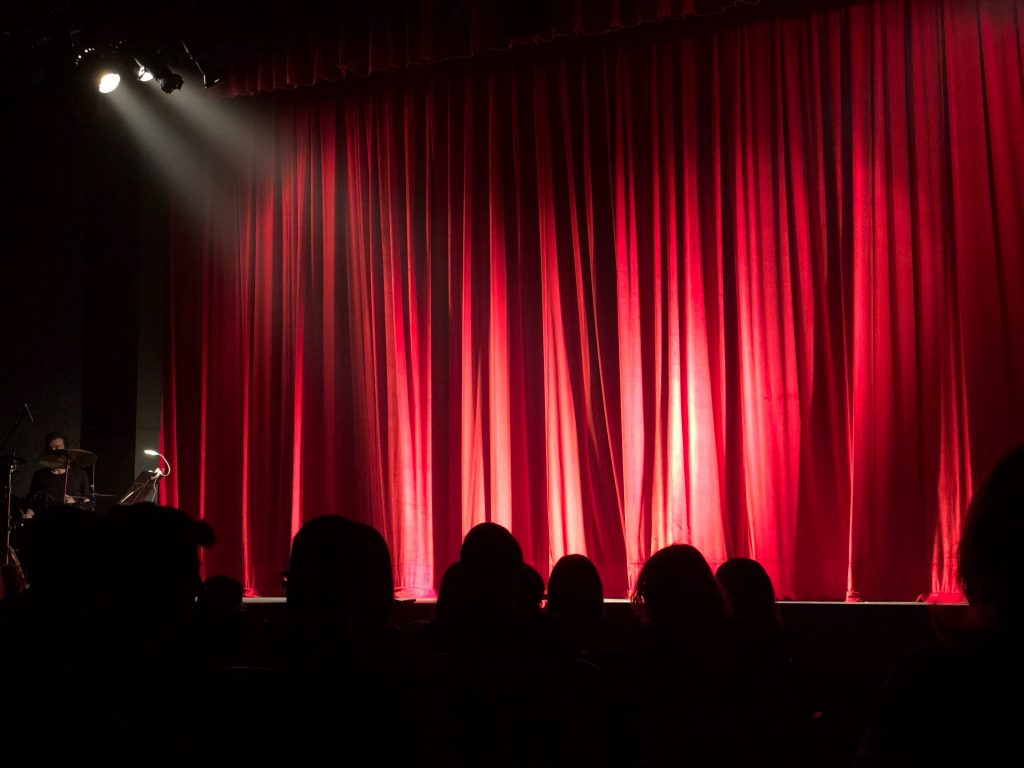In late 1974 / early 1975, a new kind of theatre took India by storm. Naya Theatre, helmed by Habib Tanvir and Moneeka Misra Tanvir and comprised of professional Nacha[1] performers, gave audiences across India Charandas Chor, a gleeful play that told the story of a thief who did not lie. It was a fast-paced play, that flowed across locations — a village street to a village maidan to a temple to a granary to the treasury to the queens court — without any change of sets, without any break in the action. The scenes were suggested by the way the actor’s moved or stayed still in relation to each other, by the way they portrayed characters, and by the way the stage was lit in different scenes. The actors moved like quicksilver across the space, establishing situations and moving the story forward with an enviable lightness of touch and ease of presence. They sang, they danced, they had the audience enthralled with their exuberance, they had them delighted with their impeccable comic timing. And then, suddenly, the play turned — the queen ordered Charandas’ death. Silence. The audience who had been having a rollicking time till then, came crashing down to earth, unable to comprehend this turn of events. The actors who kept them in splits throughout performed the death and its aftermath perfectly, never holding a moment too long, never overplaying the situation. There was no drama, no dramatic outpouring of grief. Just a dignified procession of Satnamis,[2] transforming the platform of Charandas’ death into their chowk with their white flag, paying tribute to Charandas as an upholder of truth. ‘Satya hi ishwar hai, ishwar hi satya hai’ — their dharma —- is the last refrain that rang in audiences’ ears as the play came to a close.
Audiences in India had never seen anything like this before. Urban and small-town audiences, generally cut off from rural performance practices, had not experienced the performative brilliance and playful abandon that the Nacha performers of Naya Theatre brought to the stage. Across India, rural performance forms have no fourth wall — a term that refers to an invisible wall between audiences and performers which allows actors to behave as if no one else is present. Popular rural forms have key characters constantly turn to the audience and talk to them — they build an active relationship with their audiences, sometimes laughing with them, sometimes laughing at them, improvising on the spot. Rural forms are also commercial enterprises —- they need to earn enough money from the audiences to stay alive. They have to keep the audience hooked through all night performances, and the Nacha form of that time did it through slick and alert physical comedy and plenty of humour. Last but not least, most rural forms tend to have excellent music and singing that runs through the performance — here too, musicians play live on stage, and there is often banter and playfulness between the musicians and performers. The Naya Theatre actors therefore excelled in performance, were ingenious in their improvisation, and had the skills to utterly charm their audiences.
Naya Theatre was not however bringing Nacha on stage. It was creating an entirely new kind of theatre, born out of a creative dialogue between Habib Tanvir and the Nacha performers who joined him, supported creatively and logistically by Moneeka Misra Tanvir who was a theatre director in her own right. Habibsaab was a Hindustani poet who had worked with the Indian People’s Theatre Association through its heyday around Indian independence. He had gone on to train in theatre in the UK — first the Royal Academy of Dramatic Art (RADA) which he rejected, and then the Old Vic which had a lasting effect on his theatre thinking. He had then gone on to tour Europe, earning his way through writing and performance collaborations. In 1958, four years after his return from Europe, he went to watch an all-night Nacha performance and fell in love with what the performers brought to the stage. Habibsaab recalled:
“They presented three or four skits. There was Madan Lal, Thakur Ram, Shiv Dayal, Bhulwa Ram, Jagmohan… and what comedians these fellows were! I was fascinated. I went up to them and said, would you like to come to Delhi and join me in a production? They were happy to do so.“
These performers were soon joined by Lalu Ram, whom Habibsaab termed “one of the best singers in Chhattisgarh”, and then Fida Bai and Mala Bai. Fida Bai played the female lead in Naya Theatre productions till she could no longer perform, and brought to the varied roles a remarkable sensitivity and brilliance, marking her as one of the most outstanding performers this country has ever seen.
Habib Tanvir, in keeping with post-independence times, was seeking a new Indian theatre, one that reflected our lived culture, and one that could reach all Indians. In the Nacha performers, he found the partners he desired, and for 13 years, they experimented together, trying to create theatre that worked with the abandon of Nacha but followed the theatre practice that Habibsaab had learned in the West. They kept failing, unable to make it click. Under Habib Tanvir’s direction, the actors were simply unable to deliver the same brilliant fluidity that was the hallmark of their Nacha performances. Eventually Habibsaab came to realise that his approach was the problem. He was constricting the actors with his western blocking techniques,[4] and stopping the natural flow of their body and verbal language by asking them to work in Hindustani — a language alien to them.
So Habib Tanvir did something remarkable. He entirely changed his way of working. What happened next is best described in his own words:
“It took me time to realise two basic approaches to working with these folk actors—mother tongue and freedom of movement.
I began to use Chhattisgarhi and I improvised, allowing them the freedom, and then came pouncing down upon them to crystallise the movement— ‘there you stay!’ And they began to learn.
I started asking them to improvise along with me and they opened up. Then I grew with them, learning new lessons in theatre.“ [5]
This shift marked the turning point for Naya Theatre. They created a performance piece called Gaon ka Naam Sasural Mor Naam Damaad, which resonated with audiences across villages, towns and cities. Then came Charandas Chor, which won hearts in India and went on to take the Edinburgh Fringe by storm in 1982. This was followed by plays like Bahadur Kalarin (exploring incest) and Mitti ki Gadi (Sudraka’s Mrichchakatika). It quickly became apparent that Naya Theatre could provide unforgettable theatre experiences across the spectrum from comedy to tragedy. Their canvas was vast and unlimited — no story was beyond reach. Their productions drew freely from existing Nacha performances (Ponga Pandit, Gaon ka Naam Sasural) as well as from folk legends and stories (Charandas Chor, Bahadur Kalarin, Hirma ki Amar Kahani). They commented on socio-political issues ranging from development (Sadak) to the Bhopal gas tragedy (Zahreeli Hawa). They created Chhattisgarhi versions of Indian and Western classics, including Mitti ki Gadi (Sudraka), Mudrarakshas (Vishakhadatta), Kamdev ka Apna Basant Ritu Ka Sapna (Shakespeare’s Midsummer Night’s Dream),[6] Lala Shoharat Rai (Moliere’s La Bourgeois Gentilhomme), Raj Rakt (Tagore), Jis Lahore Nai Dekhya (Wajahat), Shajapur ki Shantibai (Brecht’s The Good Person of Szechwan) and Dekh Rahein Hain Nain (inspired by a description of Stefan Zweig’s Eyes of the Undying Brother). Through a mixture of intelligent improvisation facilitated by Habib Tanvir, masterful playwriting, captivating music and song rooted in Chhattisgarhi culture, and the uninhibited performances of the Nacha actors, Naya Theatre offered audiences play after play that captured imaginations and hearts. Stories of substance and depth, of socio-political import, of enquiries into the human condition, were offered up with a captivating lightness of touch and exuberance of spirit. This was theatre that lifted people up even as it asked people to engage deeply. Audiences across India and indeed, the world, were enchanted.
Naya Theatre’s naya-ness certainly lay in the style of theatre it brought to the stage. But underlying that was another naya-ness, deeply rooted in the dreams of a newly independent India. It was a recognition that the growth of the country lay in the growth of the country’s culture, and that required the participation of all people. For this to happen, the privileged — those with access to education and resources —- had a role to play as catalysts, and Habib Tanvir saw himself exactly in this role:
“It is a fallacy to suppose that because a people are primitive in their economy and other behavioural patterns of life, their community expressions too will remain primitive in both form and substance. They have survived because of their adaptability and their relevance to the society they depict. They certainly have flexibility enough to portray the changing times, should the changing society allow them to be and grow . . .”
We need to create an environment that is conducive to the growth of the country’s culture. And for this, we need outsiders functioning as catalysts (not as teachers) operating in the villages who will have the sensitivity and vision to transform the folk arts and inject into their forms their own world consciousness.
This process has started. It needs, however, to be accelerated, for in this process alone lies all hope of the future of Indian theatre.[7]
Naya Theatre was naya in that it was conceived and carried out as a critical socio-political act, a way for rural people to grow and claim their place in the country and in the world. It offered a new way of collaboration between people carrying rural performance knowledge and those who had learned global theatre techniques — a creative collaboration that led to a theatre practice that was rooted, Indian, contemporary and utterly delightful, all at once.
Naya Theatre toured for 50 long years under the leadership of Habib Tanvir, crisscrossing the country and visiting the world as a professional touring company. Generations of Nacha performers formed the core of the company, joined by other rural and urban performers to form the extended company as and when required. Naya Theatre’s audiences spanned villages as well as semi-urban and urban areas. Over 50 years, these audiences lapped up the magic of their theatre. Through Naya Theatre, the people and culture of Chhattisgarh became visible and celebrated across India — not as museum pieces of traditional culture which is often put out in national festivals, but as contemporary excellence, engaging with the stories and cultures of the world and bringing their own consciousness and performance excellence to bear on it. The ultimate naya-ness of Naya Theatre — one our country needs desperately today — was that it was anchored in creative dialogue and an unflinching belief in their collective potential. The group held together for 13 long years, struggling to express their creative brilliance but never giving up on its possibility. And then, once they found that sweet spot, they swept us all into their orbit, leaving us with an intoxicating taste of what was possible when people worked to come together instead of letting their differences separate them. Naya Theatre offered us a powerful naya vision of what we could be together. It is a vision we need to remember and reach for today.
[1] Nacha is a performance form popular across Chhattisgarh, a form of comedy that integrates music, dance and drama into a theatrical performance. It boasts a keen and discerning audience.
[2] Satnamis are dalits who follow Guru Ghasidas, originally a dacoit, who established the dharma—satya hi ishwar hai, ishwar hi satya hai. Truth is their god.
[3] Sameera Iyengar ed. On the Road with Naya Theatre. May 3 entry.
[4] Blocking in theatre is letting the actors know where to move to on stage, where to stand. It is essentially the choreographing of the actors’ movements on stage through the play.
[5] Sameera Iyengar ed. On the Road with Naya Theatre. July 7 entry.
[6] Kamdev ka Apna Basant Ritu ka Sapna is Shakespeare’s Midsummer Night’s Dream minus the characters of the court, due to the British collaboration falling through.
[7] Sameera Iyengar ed. On the Road with Naya Theatre. June 11 & 15 entry.








